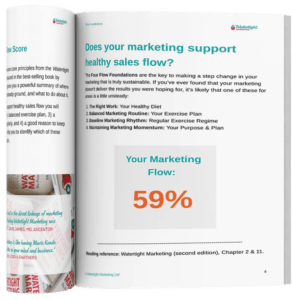Prefer to listen than to read?
This post is also available over on our PodBlog
There’s nothing more predictable in business than the unexpected. But, just because you don’t know exactly what’s coming down the tracks, does not mean that your marketing budget can’t be ready.
There are two key ways to do this. The first is to set aside a sensible contingency, and the second is to have check points for stepping up or down on a three level marketing activity plan.
Make the most of marketing moments…
A contingency budget is as important, if not more, for unexpected opportunities as it is for unforeseen problems. From a marketing perspective, the following things might happen that give you a perfect chance to grab the limelight:
- A news story breaks that powerfully illustrates the need for your products (known as an ‘issues jump’ in PR circles).
- A competitor goes under or experiences a crisis of some kind.
- A new event or publication is launched that is perfect for your market.
- The next Twitter, Facebook or Google+ is launched.
These things happen to someone’s business every day. If it’s yours and you have no pot of cash to turn to, you either have to stand frustrated on the sidelines – or raid your baseline budget, thus jeopordising your sales pipeline later in the year.
Minimise the impact of bad news days…
Of course, there are also potentially negative scenarios that you may want some cash to put towards should they arise. This is what ‘crisis communications’ is all about, for example:
- Some sort of reputational damage to your business.
- A sudden loss of a big client or reduction in spend from a key market.
- Loss of a high profile person to competitor.
- I’m sure we can all think of more.
I’d recommend that you put together a vanilla template plan for an ‘issues jump’ campaign, and a ‘crisis communications’ plan, and put aside the cost of each. If your budget runs across the calendar year, and you come to October / November having not spent this money, it can very usefully be put towards a really innovative seasonal campaign at the end of the year. These can be really powerful. So, whether you maximise an opportunity, minimise a problem, or do something exciting at the end of the year – this contingency budget will not go wasted.
It’s a marketing budget, not a piggy bank!
Whilst we’re talking about contingencies… a word of warning. Don’t let your marketing budget become the contingency pot for the rest of the business.
All businesses need a level of flexibility in their financial management, and marketing is a natural go-to budget when you need to reign in costs, or even splash some cash. There are two things I’ve often seen happen when businesses haven’t put in some pre-thought to how they would make the decision about a variation in spend. In a situation where a saving needs to be found, they will arbitrarily cut an activity of broadly the amount they need to save – which can often leave a gaping hole in the buying journey that does not become apparent until some months later as the buying timeline takes its course. And, in a situation where some additional cash becomes available, an ill considered one-off activity (like an ad campaign, big event, or sponsorship) is undertaken – which can sometimes overweight the awareness stage of your buying decision leading to a peak in demand that can be tricky to manage, or more often, simply has no real benefit because the stepping stones thereafter have not been built in.
As easy as A, B, C…
To avoid this in your business, you need to have mapped out three levels of marketing activity – low cost (A), middle cost (B) and high cost (C). And, if you’ve established a sensible time horizon in which to assess marketing effectiveness, you can use that as natural checkpoints to review your marketing spend. Assuming you went the middle cost activity plan, you already have your step up, and step down in mind. So, at these checkpoints you can review whether you’re on, above, or below target spend, or the money available has changed, you can adjust your spending accordingly without leaving a hole in your plan.
Taking time to plan your budget in this way is really powerful. It will put you well ahead of your competition, both in terms of the robustness of your activities and the speed in which you can respond to a changing situation.
© Bryony Thomas | Cartoon by Simon Ellinas

Bryony Thomas
Author & Founder, Watertight Marketing
Bryony Thomas is the creator of the multi-award winning Watertight Marketing methodology, captured in her best-selling book of the same name. She is one of the UK's foremost marketing thinkers, featured by the likes of Forbes, The Guardian, Business Insider and many more, and in-demand speaker for business conferences, in-house sales days and high-level Board strategy days.


